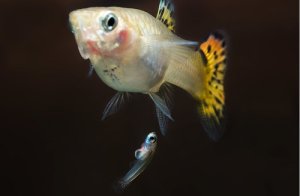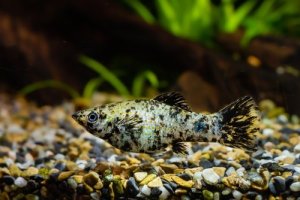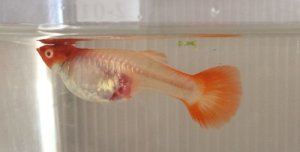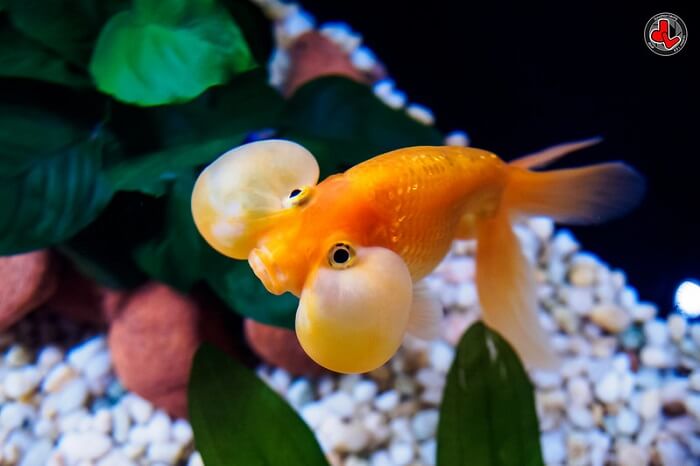
Breed Overview
| Origin | China |
| Lifespan | 10-15 years |
| Size | 5 inches/13 cm maximum – one of the smallest varieties |
| Colour | Orange, red, gold, black, calico, bi-color |
| Food | Omnivorous |
| Tank Size | Minimum 20-30 gallons/76-114 liters |
| Temperament | Gentle and friendly |
| Water Type | Freshwater |
| Water Temperature | 65-74 F/18-23 C |
| Water pH | 7-8 |
| Difficulty Level | Advanced |
Species Summary
The bubble eye goldfish is an unusual and distinctive variety of fancy goldfish that also doesn’t grow as big as other varieties. It is immediately noticeable by the large fluid-filled sacs under its eyes, and on seeing these, you may wonder how the fish developed such a feature.
The bubble eye is a selectively bred goldfish variety that developed in China, like many other goldfish types – yet unlike others, this was much later, only in the early twentieth century. It might look like a variant of the celestial-eye goldfish. Actually, humans selectively bred it from the toadhead goldfish, a fish that naturally had small sacs of fluid under the eyes, eventually selecting each generation for bigger and bigger eye sacs.
Tank Parameters And Setup For Bubble Eye Goldfish
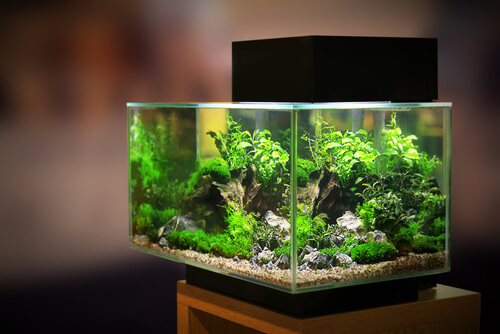
Basic Water Conditions:
- Size: 30 gallons/114 liters to begin with and an additional 10 gallons/38 liters per extra fish. You may read that because these fish are small, they can survive in a 20 gallon/76 liter tank – but bigger is better as goldfish still produce a lot of waste and a larger tank means more clean water per fish.
- Filtration: For these fish, under gravel filters are sometimes recommended. However, these divide opinion amongst professional aquarists due to the fact that you cannot properly clean them. Simply put, they are filters that sit under the gravel and substrate, and, once they are there, they are there.
However, there are some benefits to using one for bubble eye goldfish, as these slow-swimming fish are often likely to get sucked against the filter. This can often lead to their eye sacs bursting.
Under gravel filters also essentially turn the substrate into part of the filter – gravel provides a great biofilter, promoting the growth of the bacteria that break down waste products. Combined with plants, this can make your tank a self-sustaining ecosystem that naturally filters nitrates out of the water.
Otherwise, you can use a regular canister filter as with other delicate fancy goldfish and ensure it is outfitted with foam. All filter flow rates should be 4x the total tank capacity.
- Ammonia and Nitrates: 0
- pH level: 7-8
- Water Hardness: 5-19 dGh
- Temperature: 65-74 F/18-23 C
- Lighting: LED
- Tank Maintenance: change the water by a third once per week, using a specialist aquarium vacuum. The filter should be wuashed gently in dirty tank water every three months unless using an under gravel filter.
Creating A Bubble Eye Goldfish Habitat
1. Plants
The bubble eye is one type of goldfish where plastic plants are an absolute no. Why? That’s because these plants can be sharp and therefore damage your fish’s delicate eye sacs. Some people opt for fabric plants instead, but these can often have plastic parts that help them maintain their structure. To be on the safe side, a living, planted aquarium with plants like cabomba, elodea, and java fern is best for these fish. It also helps maintain water quality as plants absorb nitrates, plus, they look spectacular.
2. Substrate
For these goldfish, a sandy or gravel substrate is safest. The trouble with rocky substrates is that when rooting around for food, they can damage your fish’s eyes. If using an under gravel filter, remember gravel provides a great environment for the growth of beneficial bacteria.
Otherwise, a sandy substrate layered over specialist aquarium soil can provide an aesthetically pleasing top layer in a planted tank that helps your plants root, too.
Choosing The Best Tankmates
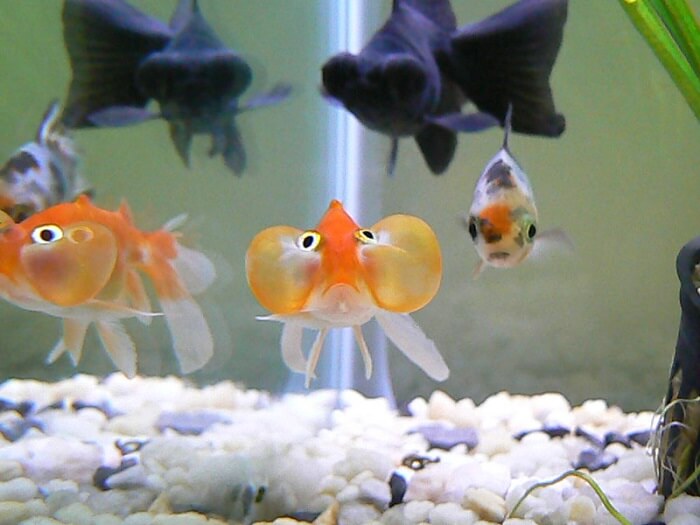
You may wonder if, as fancy goldfish, the bubble eye goldfish can get on with other fancies like the fantail, telescopic goldfish, or black moor. In truth, even among fancy goldfish, there are varying levels of swimming ability.
As the bubble-eye goldfish is inhibited by its eye sacs it can be a slow swimmer, but in addition, this fish doesn’t have a dorsal fin, which can also affect its ability to balance. In this way, it can even be outcompeted by other fancy goldfish. The best goldfish tankmates are those that also lack a dorsal fin and have impaired vision like the telescopic goldfish, celestial eye goldfish, or a set of other bubble-eye goldfish.
Alternatively, tankmates that aren’t goldfish can be a great choice as your bubble eye won’t attack and kill them. There are lots of aquarium invertebrates that can make a great addition to your tank, largely keeping out of your fish’s way.
Feeding Bubble Eye Goldfish
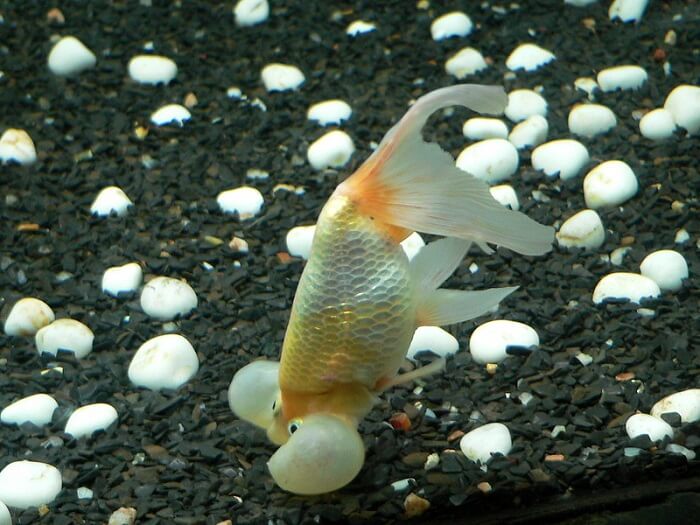
Bubble-eye goldfish can have trouble reaching food due to their eyesight and poor swimming abilities. Sometimes, this can be a reason why your goldfish is not eating.
Prevent this by avoiding two kinds of food – first, floating pellets or flakes, as these fish can gulp down air and as a result can develop swim bladder disease. Their egg-shaped bodies actually mean they are more at risk of this than hardy goldfish.
The other kind is free swimming live food. These are live invertebrates such as daphnia, tubifex worms, and glass worms that you can feed some types of goldfish. However, the bubble eye goldfish will struggle to catch them, which is why when you feed protein, choose frozen protein from your aquatics store – most of them have a freezer stocked with it that you’ll be familiar with if you’ve kept goldfish before.
Otherwise, feed a sinking pellet food like with other goldfish and vary your fish’s diet with vegetable matter like lettuce, sweet potato cubes, and duckweed. Any vegetables should be cut small enough so your fish can eat them without choking.
One other thing to note is that as these fish won’t be able to find food as quickly, it’s best to stay by the tank after feeding. Then, remove any food that isn’t eaten in five minutes. This means it won’t rot and pollute the water.
Temperament And Behavior
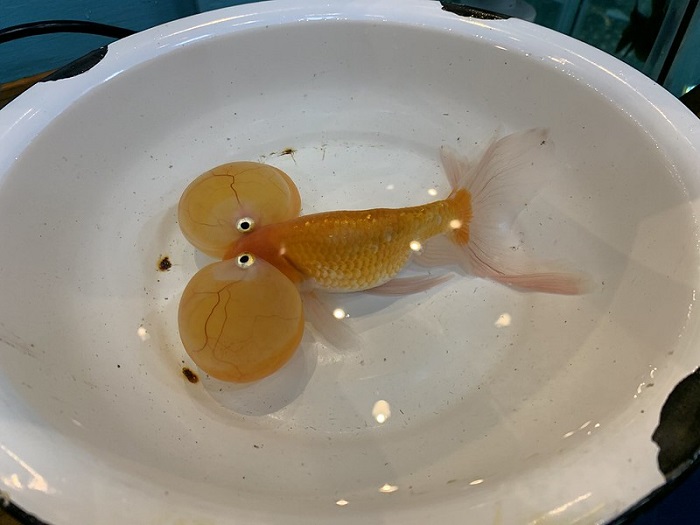
Perhaps due to its hindered swimming ability, the bubble eye goldfish is one of the most peaceful goldfish out there, even more so than the black moor.
They don’t always show as much curiosity and excitement in their surroundings. But they nevertheless enjoy lazily swimming through a planted tank or hanging out on the tank bottom.
Although many varieties of goldfish can coexist with invertebrates if your tank is large enough, this is one of the few varieties that very rarely attempt to eat them at all! These guys will simply ignore snails, shrimp, and other tankmates.
Pests And Diseases
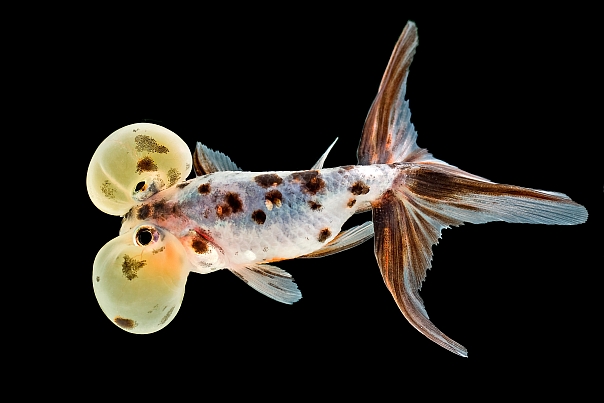
1. Swim Bladder Disease
Swim bladder disease can be caused by bacteria but the risk is also increased by your fish gulping down air, which is a reason to only feed sinking foods.
It can be particularly damaging in bubble eye goldfish because they already have trouble staying afloat due to their eye sacs which make it harder for them to maneuver through the water. It can be cured by over-the-counter antibacterial medications, but it’s best to prevent it in the first place by keeping the water as clean as possible.
2. Popeye Disease
Popeye, or exophthalmia, is a disease caused by aeromonas punctata bacteria that can affect all goldfish, bubble-eye goldfish included. It causes the fish’s eyes to stand out from its face. Despite its name, it’s a very different condition from when your fish pops an eye sac.
Popeye is good to know how to recognize in bubble eye goldfish as the eyes themselves are connected to the eye sacs, meaning that eye infections can affect the eye sac as well.
Popeye is caused by bacteria, so this means it can be treated with a variety of purpose-created over-the-counter medications that can be found in major aquatics stores or ordered online.
To spot this disease, note that it is the fish’s eyes themselves that will be standing out, as opposed to the eye sacs. The area around the eye often looks swollen and puffy.
Help! My Bubble Eye Goldfish Popped An Eye!
This alarming occurrence can be all too frequent if your bubble eye goldfish tank does not have a safe environment. Rocks, plastic plants, and pieces of driftwood can all become hazardous sharp objects that can injure your bubble eye goldfish, so it’s best to keep these out of the tank and remove any you have already.
When your goldfish pops an eye it can look frightening. The first sign that something isn’t right is that the eye sac looks deflated and is hanging below your fish’s eye, as opposed to extending out into the water. However, rest assured that with the correct care, your fish can recover.
Although the bubble eye goldfish is a delicate fish, the under-eye sacs are actually self-regenerating. This means that if your fish pops an eye, the biggest likelihood is the eye sac will simply grow back! However, this is still a serious occurrence that should be treated accordingly.
The biggest danger is that your fish’s eye sac can become infected by bacteria. This can be painful for the fish and ultimately lead to its death as it will weaken its immune system and make it more susceptible to other diseases.
To solve this and give your fish the space to heal, put your fish in another tank and treat the water with aquarium salts as soon as you notice the popped eye. This is just one of the reasons that with delicate goldfish such as the bubble eye, it’s always good to keep a spare tank on hand in case you ever need to isolate the fish.
It’s also good to monitor water parameters especially closely because the dirtier your water, the more likely an infection is. Keep ammonia and nitrates to absolute zero and test on a regular basis until your fish has healed.
3. Inside The Eye Sacs
It is a common misconception that the eye sacs of this goldfish are filled with air. However, they are actually filled with a fluid called lymph, which is what lets them regenerate if popped.
These regenerative qualities have also been studied by science, which found that they have the ability to promote cell growth.
Breeding Your Bubble Eye Goldfish
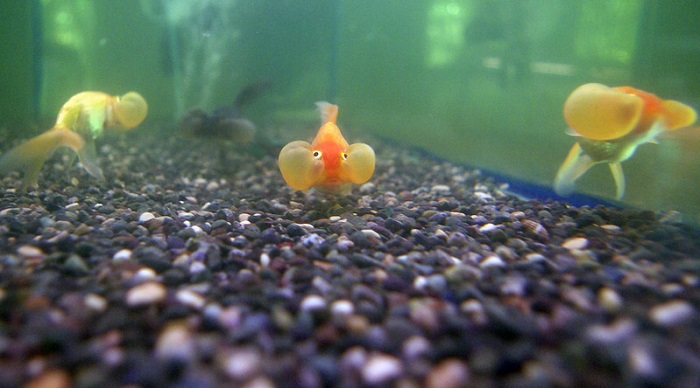
Bubble eye goldfish can be bred more or less in the same way as other varieties of goldfish. However, due to difficulties surrounding their eye sacs, this shouldn’t be attempted unless you are already experienced with breeding other delicate varieties of fancy goldfish such as the celestial eye or oranda. However, if you are familiar with how goldfish mate, here are a few special points regarding the bubble-eye:
- Bubble eye goldfish don’t develop eye sacs until 6 months of age. Therefore if you’re worried because your fry don’t have any eye sacs, have no fear. They will grow into fish that look just like their parents.
- Bubble eye goldfish start off a brown color as fry. Likewise, their color changes as they grow older.
- These fish may be harder to breed artificially than other species due to the delicacy of handling them. Whilst with some fish you can rub the vent of the female to get her to release eggs, this can be risky with this fish. Therefore it’s best to let breeding happen naturally.
- Whilst pregnant with eggs, the female may become a slightly slower swimmer. As these fish are slow normally, take extra care to ensure your female is able to access enough food, and feed extra protein when your fish is carrying eggs.
- Bubble eye goldfish can’t withstand the same temperature fluctuations as hardier goldfish. Therefore, when lowering the breeding tank temperature, only go as low as 60 F/16 C. This is enough to mimic the cold weather before spring, and the temperature rise that signals them to spawn- yet, it won’t damage your fish.
Final Thoughts
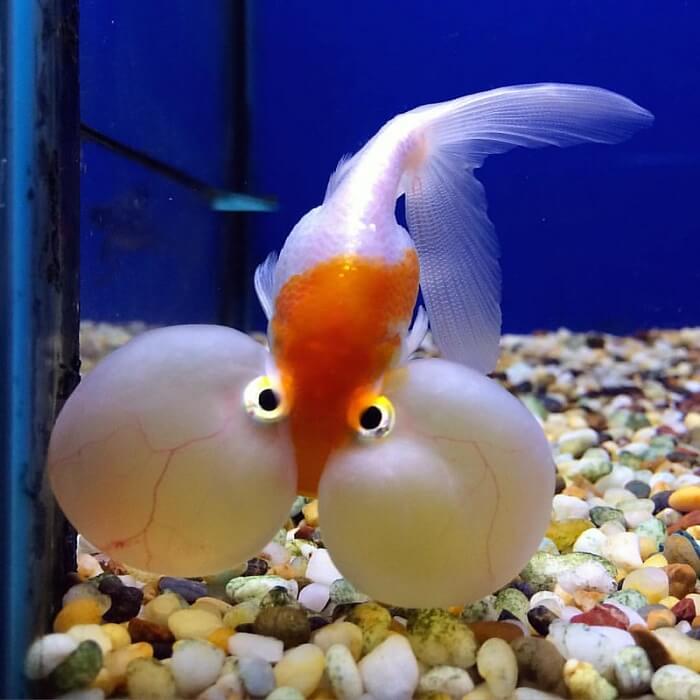
Bubble eye goldfish are challenging fish to keep and they’re definitely not for everyone. However, in the hands of an experienced aquarist, they make beautiful pets that can actually live much longer than expected. Plus, they have the added bonus of being small enough that you can still keep them even if you don’t have a lot of space!


